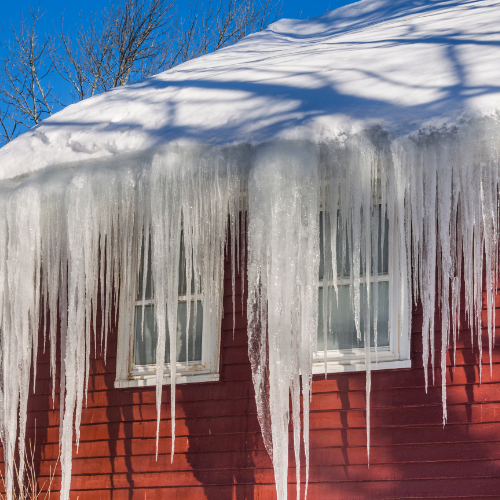Table of Contents
As a homeowner in the Twin Cities, you know how important it is to have a reliable roof during snowy winters. Having an ice dam form can lead to damage that makes it hard for your roof to protect your home from the elements. With ice dams being such a winter hazard, knowing how they form is helpful. Can gutters cause ice dams?
Learning more about how ice dams develop is the first step toward prevention. Once you understand how they form, you can take steps to stop this from happening. Doing so helps lower your risk of roof damage during the winter months.
Can Gutters Cause Ice Dams?
Gutters aren’t the sole cause of ice dams. However, they do play a significant role in how these blockages form. Remember that your gutters allow melted snow and ice to flow from your roof to the ground through downspouts. This runoff needs to have that clear path available throughout winter.

How Ice Dams Form
Ice dams develop when the snow melts quickly on your roof and freezes again along the edges. This can happen when your attic is too warm. Once the snow melts, it doesn’t have a chance to reach the gutters before freezing, and as this happens again and again, a blockage called an ice dam forms. Ice dams typically develop at the edges or eaves of roofs. When they’re not dealt with, they can become larger and cause damage to your home.
What role do your gutters play? If your gutters are clogged with ice, leaves, or other debris, this stops melted snow from leaving your roof. Instead, it makes ice dams worse and raises the risk of damage.
What Kinds of Damage Do Ice Dams Cause?
Ice dams prevent melted snow from going to your gutters. Rather than following this path to the ground and away from your home, water flows under the roofing shingles. It can damage the layers underneath, such as the decking and underlayment, as it gets under the shingles.
Your roof can end up with wood rot, mold, and loosened or damaged shingles that fall off. Missing shingles and damaged layers underneath make your home more vulnerable to roof leaks. A leak can cause extensive water damage to your attic and other parts of your home interior.
Ice dams can also weigh your gutters down, which can cause them to become loose or pull away from your roof. When your gutters aren’t in place, melted snow can flow against your siding, which can cause damage.
How to Prevent Ice Dams
Once they’ve formed, ice dams can be a hassle to deal with, so it’s better to stop them from happening or at least reduce this risk. You can help prevent ice dams from developing with the following steps.
Improve Attic Insulation
Remember that an attic that’s too warm is a major cause of ice dams. The heat inside your home rises and eventually reaches your attic and roof. As this heat escapes, it can cause snow to melt.
Adding insulation to your attic creates a barrier that stops heat from entering. Instead of escaping through your roof, heated air will stay in your home below the attic. This helps keep the air in your attic cooler overall, which helps prevent rapidly melting snow.
Clear Blocked Gutters
If you already have a blockage in your gutters, this increases your risk of ice dam forming. Clear out leaves and debris to give melted snow an unobstructed path to the downspouts. This can help ensure that melted snow leaves your roof instead of freezing up.
Remove Snow on the Roof
Having snow sit on your roof and build up raises the risk of ice dams. Large amounts of melted snow can fill your gutters and turn to ice if temperatures get cold enough. This can make ice dams worse and increase the risk of roof damage.
Remove snow from your roof with a roof rake. These rakes have a long handle that allows you to reach up and push snow off as you stand on the ground. Roof rakes offer a safe way to lower the amount of snow on your roof.
Call an Experienced Local Roofer in the Twin Cities
Local roofers can help you determine if your attic needs more insulation. They can also check your gutters for debris and repair if they’re damaged to help ensure that melted snow can flow through them.
If you need help preventing ice dams, contact Midwest Roofing Siding and Windows. Our reliable roofers in the Twin Cities can help lower the risk of ice dams forming on your roof this winter.
